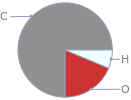Input interpretation

benzyl(S)-(-)-2-hydroxy-3-phenylpropionate | elemental composition
Result

Find the elemental composition for benzyl(S)-(-)-2-hydroxy-3-phenylpropionate in terms of the atom and mass percents: atom percent = N_i/N_atoms × 100% mass percent = (N_im_i)/m × 100% Plan: • Write the chemical formula and gather atomic masses from the periodic table. • Determine values for N_i, m_i, N_atoms and m using these items. • Finally, compute the percents and check the results. Write the chemical formula: C_6H_5CH_2CH(OH)CO_2CH_2C_6H_5 Use the chemical formula to count the number of atoms, N_i, for each element and find the total number of atoms, N_atoms, per molecule: | number of atoms C (carbon) | 16 H (hydrogen) | 16 O (oxygen) | 3 N_atoms = 16 + 16 + 3 = 35 Divide each N_i by N_atoms to calculate atom fractions. Then use the property that atom fractions must sum to one to check the work: | number of atoms | atom fraction C (carbon) | 16 | 16/35 H (hydrogen) | 16 | 16/35 O (oxygen) | 3 | 3/35 Check: 16/35 + 16/35 + 3/35 = 1 Compute atom percents using the atom fractions: | number of atoms | atom percent C (carbon) | 16 | 16/35 × 100% = 45.7% H (hydrogen) | 16 | 16/35 × 100% = 45.7% O (oxygen) | 3 | 3/35 × 100% = 8.57% Look up the atomic mass, m_i, in unified atomic mass units, u, for each element in the periodic table: | number of atoms | atom percent | atomic mass/u C (carbon) | 16 | 45.7% | 12.011 H (hydrogen) | 16 | 45.7% | 1.008 O (oxygen) | 3 | 8.57% | 15.999 Multiply N_i by m_i to compute the mass for each element. Then sum those values to compute the molecular mass, m: | number of atoms | atom percent | atomic mass/u | mass/u C (carbon) | 16 | 45.7% | 12.011 | 16 × 12.011 = 192.176 H (hydrogen) | 16 | 45.7% | 1.008 | 16 × 1.008 = 16.128 O (oxygen) | 3 | 8.57% | 15.999 | 3 × 15.999 = 47.997 m = 192.176 u + 16.128 u + 47.997 u = 256.301 u Divide the mass for each element by m to calculate mass fractions. Then use the property that mass fractions must sum to one to check the work: | number of atoms | atom percent | mass fraction C (carbon) | 16 | 45.7% | 192.176/256.301 H (hydrogen) | 16 | 45.7% | 16.128/256.301 O (oxygen) | 3 | 8.57% | 47.997/256.301 Check: 192.176/256.301 + 16.128/256.301 + 47.997/256.301 = 1 Compute mass percents using the mass fractions: Answer: | | | number of atoms | atom percent | mass percent C (carbon) | 16 | 45.7% | 192.176/256.301 × 100% = 74.98% H (hydrogen) | 16 | 45.7% | 16.128/256.301 × 100% = 6.293% O (oxygen) | 3 | 8.57% | 47.997/256.301 × 100% = 18.73%
Mass fraction pie chart

Mass fraction pie chart